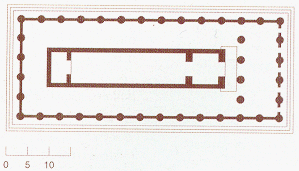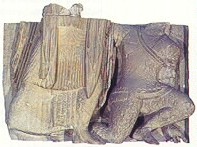|
 Selinus
is really one of the most beautiful archaeological resorts, one of the
richest of art and history. Selinus
is really one of the most beautiful archaeological resorts, one of the
richest of art and history.
Walking among its monuments is like skimming through history and art
pages, and among these monuments we find the temple F, probably
dedicated to Athena, Jove's favourite daughter, or to Dyonisus, god of
joy, drama, fertility, wine.The building is a very example of doric
style, situated in a simple landscape always full of an immense
beneficial and restful peace.
Primary building in a comprehensive review of doric architecture, it
covers a large rectangular surface: it is 65,76 m. long, 37,111 m. wide,
with an area of 1.802, 4816 square meters.
Its columns without base, six of which were at the
frontons and fourteen at the long sides, rise up on there
well-proportioned steps.
In ancient times they were used as seats by people participating in
sacrifical rites.
The diameter of these columns is 1,82 in the base; they're 9, 11 m. high
and are decorated with 20 flutes.
The interior of the temple was divided into the cella
(naos) 40,66 x 7,11 m. large, preceded by a simple "in antis"
hall with four columns (pronaos), provided with an "adyton",
the chapel destined to lodge the statue for the cult of the god.
The building was the only one with a pseudo-periptery shape, that's to
say not surrounded by free columns, but by columns which marked out the
development of an uninterrupted wall, 4,70 m. high and 0,37 m. thick.
Each panel had an architrave and vertical pillars, to give the
impression of a succession of doors.
 Architect's
care is devoted to the essentiality of the structures, strengthened
presumedly by the need of providing a hiding for particular rituals. Architect's
care is devoted to the essentiality of the structures, strengthened
presumedly by the need of providing a hiding for particular rituals.
Even if the size of this ruin is bug, we can notice that it remains just
a few, comparing with the group of the original building and so we can
infer that a great part of the materials it was constitued of was
removed in an imprecise period. From this temple come the metope s today
in the archeological museum in Palermo, datable to 530-525 B.C., showing
two episodes of gigantomachy.
|
 Selinus
is really one of the most beautiful archaeological resorts, one of the
richest of art and history.
Selinus
is really one of the most beautiful archaeological resorts, one of the
richest of art and history. Architect's
care is devoted to the essentiality of the structures, strengthened
presumedly by the need of providing a hiding for particular rituals.
Architect's
care is devoted to the essentiality of the structures, strengthened
presumedly by the need of providing a hiding for particular rituals.